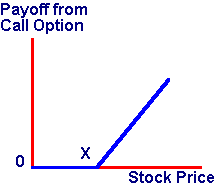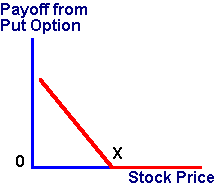 OPTIONS:
INSTITUTIONAL DETAILS
OPTIONS:
INSTITUTIONAL DETAILS Restart to return home
 OPTIONS:
INSTITUTIONAL DETAILS
OPTIONS:
INSTITUTIONAL DETAILS
Introduction to Options
An
option is a contract between two parties:
a buyer and a seller (or option writer).
The
buyer pays the seller a price called the premium and, in exchange, the option
writer gives the buyer the right (but not the obligation) to buy or
sell some underlying security at some pre-specified price for some pre-specified
period of time.
An
option to buy is a call option, and an option to sell is a put option.
The pre-specified price is called the strike or exercise price, and the
option's life is called the time to maturity or time to expiration.
If
the right to exercise is "any time until maturity" then the option
is called an American option. If
the right to exercise is only "at the time of maturity" then the
option is referred to as a European option.
The majority of options traded are American options.
All stock options, for example, are American, as are most options on
stock indices, on futures, and on currencies.
Commonly traded European options include those on the S&P 500 index
and on some currencies.
The
specified rights and obligations in an option contract determine the cash
flows from the contract. Consider
the rights and obligations specified by a European call option.
This option can be exercised only at its time of maturity, and the
decision whether to exercise depends upon whether the option finishes
in-the-money or out-of-the-money. An
option is said to be in-the-money or out-of-the-money based upon its current
exercise value.
For
example, assume the possible stock values at the time a European strike 30
call option expires are 20 and 40. If
you hold one call option, you have the right, but not the obligation, to buy
the stock for 30.
Suppose
the stock value is 20. If you
exercise your option, you are buying the stock for 30, when you could acquire
it in the market for 20. That is,
you would realize a loss of 10 by exercising.
In this case the option is out-of-the-money.
If,
on the other hand, the stock price is 40, it pays you to exercise the option.
By exercising, you get to buy the stock for 30 when its current price
is 40. Here your option is
in-the-money.
In summary, your exercise decision at the end of the life of a European option is determined by whether the option is in-the-money or out-of-the-money. The exercise decision for an American option is not this straightforward and is discussed in greater detail in the online support texts.
In
general, if X is the strike price
and S is the value of the stock at
the time the option expires, then the payoff C
from a call option is
C
= max{0, S - X}.
This
terminal payoff for a call option is shown in Figure 1.1:
Figure
1.1
Terminal
Payoff for a Call Option

The
call is worthless if S < X, but
its value increases linearly with the stock price as long as S
> X. That is, if you own a
call option, you receive cash from exercising if the stock price is greater
than the exercise price. Otherwise,
you do not exercise the option.
Of
course, owning a call requires buying it, so you pay something for it.
Whether you gain from owning a European option at the time of maturity
depends upon two things. First,
it must finish in-the-money and second, the amount by which it finishes
in-the-money must exceed what you paid for it.
Of course, if significant time has elapsed between the time at which
you purchase the option and the time you exercise it, you must also account
for interest lost on the money you used to buy the option.
The
terminal payoff for a put option is:
P
= max{0, X - S}, shown in Figure 1.2 where "terminal" means at
maturity.
Figure
1.2
Terminal
Payoff for a Put Option

In
this case, you receive cash from exercising if the price of the stock falls
below the strike price.
Otherwise, you do not exercise the option.
Institutional Details
There
are three types of stock options traded on the centralized exchanges.
Regular stock options, stock LEAPS (Long-Term Equity Anticipation
Securities), and FLEX options (flexible).
Each stock option is issued by the Options Clearing Corporation.
Specific contracts however are traded on different exchanges.
Contractual specifics, such as last trading day, settlement day for
each option are common across the exchanges trading OCC options.
This greatly simplifies the trading problem faced by investors and
potential investors compared to trading futures and options on futures.
Contractual standard for these other types of derivatives do not apply
across exchanges or even underlyings.
Expiration Dates
The
expiration date for OCC issued stock options is the Saturday following the
third Friday of the expiration month. The
last day of trading is the third Friday or the last business day prior to the
Saturday expiration date.
Investors must notify their brokers of their intent to exercise by 4:30
central time (for stocks) or 5:30 central time (for index options) on the day
of expiration.
Note that this is after the market in stocks closes.
Maturity Cycles
OCC issued options trade in cycles. Three quarterly cycles are used for equity options: January, February and March. Typically stock options are trading the closest two months from one of the three quarterly cycles plus the closest two months. At most there are four months of expirations trading at any point in time. You will tend to observe that the most frequently traded options are short maturity options. One reason for this is the greater sensitivity (and therefore potential control) provided by short maturity options to traders who are managing the price risk of the underlying. You will learn about these issues in the lessons on Sensitivities.
Exercise Style
Regular stock options are of the American style which means that they may be exercised on any day prior to the expiration date. A holder of a stock option that tenders an exercise notice receives delivery of the underlying physical stock. That is, they are not cash settled. Usually delivery is received on the 5th business day following the date of exercise although practices of this nature are subject to change. Settlement is at a price equal to the strike or exercise price times 100. The reason for scaling by 100 is that one option contract controls 100 shares of the underlying common stock.
Strike
Prices
The
menu of strike prices made available is based on the rule shown below.
|
Security
Price |
Strike
Price Interval |
|
|
<$25 |
$2.50 |
|
|
<$200 |
$5.00 |
|
|
>=$200 |
$10.00 |
|
This
means that if a stock price is 20, the strike prices will differ by $2.50.
If the stock price is around 50, the strike prices will differ by $5.
A typical menu of options would have set strike prices equal to $40,
$45, $50, $55, and $60.
Options
on other types of underlying assets follow other rules.
For the S&P 100 index, the interval is 5 points of the index, while
strike prices for gold options have $10 intervals when the price is below $500
and $20 intervals above $500.
Quotations
OCC
issued options are quoted in points
and fractions.
One point is $100 corresponding to the 100 shares of underlying
controlled. As
a result, a premium of 3 points corresponds to $300. The
minimum tick size by which the option premium can vary depends upon the level
of the premium.
If the premium is below 3 points then the tick size is ¼ point or
$6.25. If
the premium is at or above 3 points the tick size is 1/8 or $12.50.
The option calculator automatically computes contractual features such as time to maturity for you. You simply, enter select the desired maturity month, the desired strike price and the appropriate style of option (European or American) and the Option Tutor calculator will automatically get the current price information and compute the contractual details for you. However, it is useful to first review exactly what an option is plus some background information on the stock options before jumping in and working with stock options.
To learn more how to look up options and interpret their contractual features click on symbols and contractual features.
OS Financial Trading System, PO Box 11356, Pittsburgh, PA 15238 USA, Phone 1-800-967-9897, Fax 1-412-967-5958, Email fts@ftsweb.com,
Restart to return home
(C) Copyright 2000, OS Financial Trading System